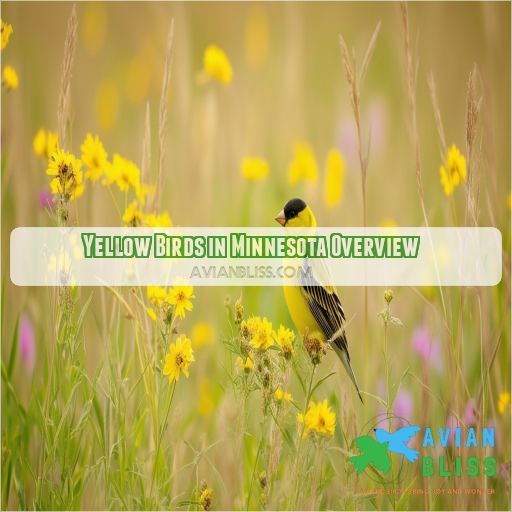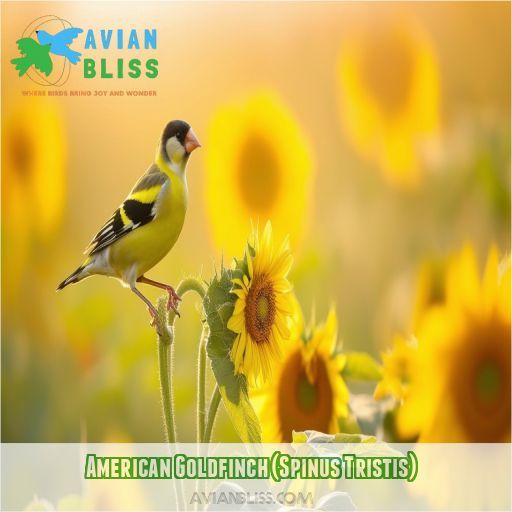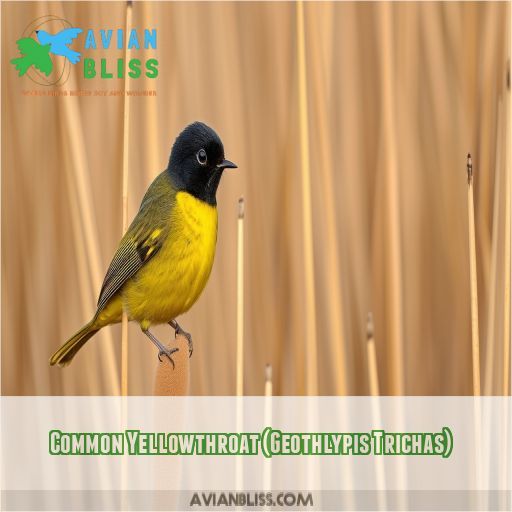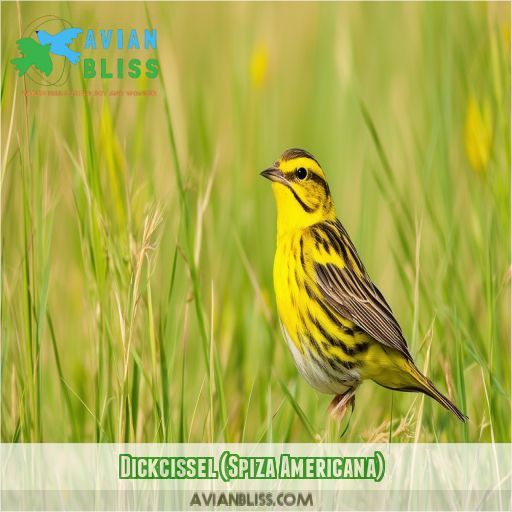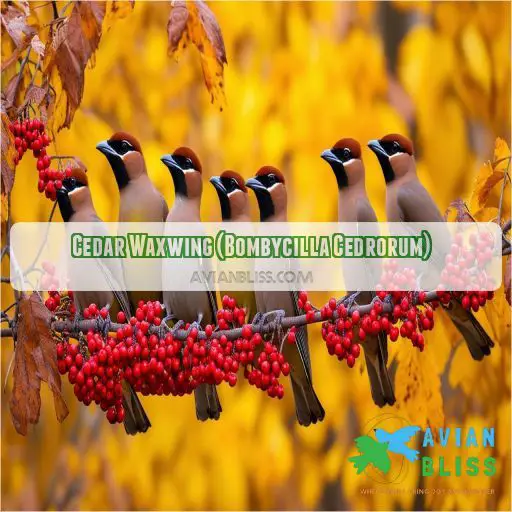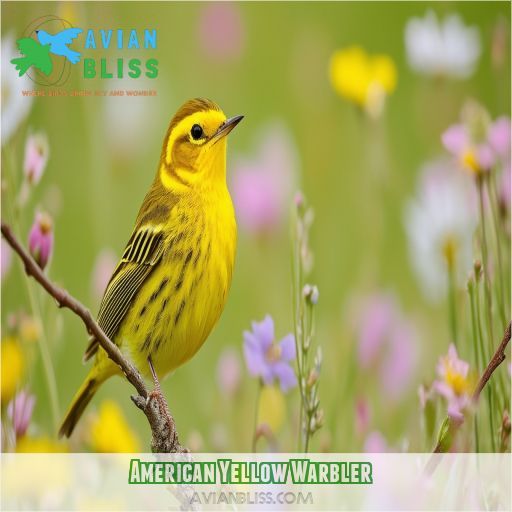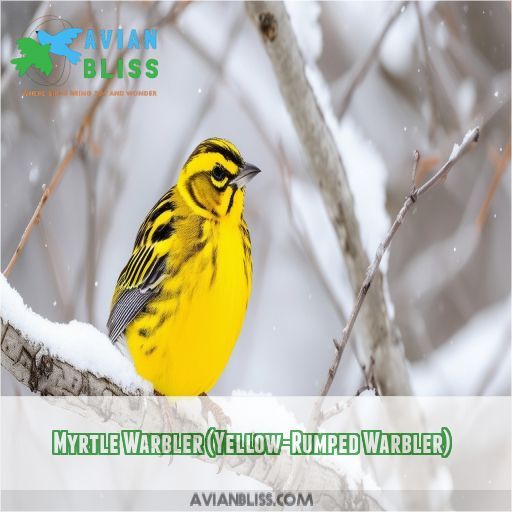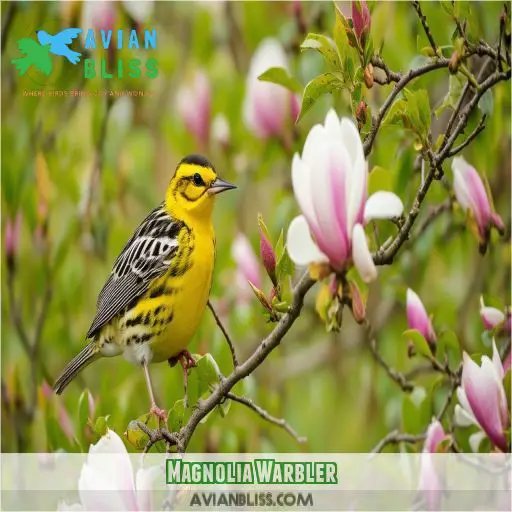This site is supported by our readers. We may earn a commission, at no cost to you, if you purchase through links.
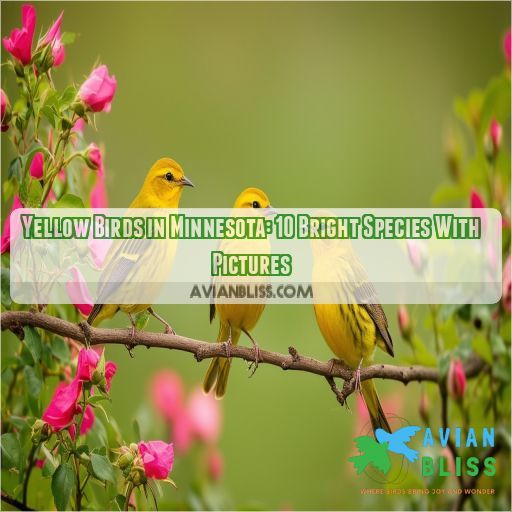
These cheery birds are a beautiful sight, and with this guide, you’ll be able to identify them with ease.
This article will take you through 10 bright yellow bird species found in Minnesota, with detailed pictures, information, and migration patterns.
Get ready to explore the vibrant avian life of the Land of 10,000 Lakes!
Table Of Contents
- Key Takeaways
- Yellow Birds in Minnesota Overview
- American Goldfinch (Spinus Tristis)
- Baltimore Oriole (Icterus Galbula)
- Common Yellowthroat (Geothlypis Trichas)
- Dickcissel (Spiza Americana)
- Cedar Waxwing (Bombycilla Cedrorum)
- American Yellow Warbler
- Myrtle Warbler (Yellow-Rumped Warbler)
- Evening Grosbeak
- Magnolia Warbler
- Frequently Asked Questions (FAQs)
- What is a yellow bird in Minnesota?
- Are there birds in Minnesota?
- When are birds most commonly spotted in Minnesota?
- What does a yellow bird look like in winter?
- What are the bright yellow birds in Minnesota?
- What is the difference between a yellow warbler and a goldfinch?
- What is the most common yellow bird?
- Do goldfinches stay in Minnesota during the winter?
- How do male and female yellow birds differ?
- Do yellow birds change colour?
- What attracts yellow birds to my garden?
- Whats on the menu for yellow birds?
- Where do yellow birds hang out?
- Conclusion
Key Takeaways
- Minnesota is home to a vibrant array of yellow birds, offering bird enthusiasts a colorful spectacle to enjoy.
- From the American Goldfinch to the Magnolia Warbler, each species has unique characteristics, behaviors, and migration patterns.
- Bird identification guides and field guides can help you become an expert at recognizing these feathered friends.
- Attract yellow birds to your garden by planting native flowering plants, providing bird feeders with seeds, and keeping a fresh water source.
Yellow Birds in Minnesota Overview
Minnesota is home to a variety of vibrant yellow birds, offering bird enthusiasts and nature lovers alike a colorful spectacle. Bird watching is a delightful hobby, and with the right bird identification guide, you can become an expert at recognizing these feathered friends.
Yellow birds in Minnesota include warblers, orioles, and finches, each with unique characteristics and behaviors. Some of these birds are year-round residents, while others migrate, providing a dynamic and ever-changing avian landscape.
This article will be your complete guide to identifying, locating, and understanding the habits of these brilliant yellow birds. You’ll learn about their habitats, diets, and the best ways to attract them to your backyard. Get ready to explore the fascinating world of yellow birds in Minnesota!
American Goldfinch (Spinus Tristis)
The American Goldfinch, or Spinus Tristis, is a bright and cheerful bird that can be spotted in Minnesota throughout the year. These finches are easily recognizable by their distinct plumage, which features a vibrant mix of yellow, white, and black feathers. Here are some key facts about this beautiful bird:
- Habitat and Diet: American Goldfinches are adaptable birds found in forest edges, plains, brush, and near thistle plants. They primarily eat seeds from the daisy family, weeds, birch, and elm trees, along with insects, maple sap, and berries.
- Nesting and Behavior: With a wild lifespan of 2 to 4 years, these active and social finches often nest near food sources, especially thistle plants. They’re known to visit bird feeders for sunflower and nyjer seeds.
- Migration and Range: American Goldfinches are year-round residents in southern Minnesota, while they migrate to northern regions during the summer. Keep an eye out for these colorful birds as you explore the state’s diverse habitats.
Baltimore Oriole (Icterus Galbula)
Now, let’s turn our attention to the Baltimore Oriole, a vibrant bird with a unique nesting habit.
Baltimore Orioles build their nests in tall deciduous trees, usually near the end of slender, drooping branches. These nests are carefully constructed hanging pouches, woven from plant fibers, bark strips, grapevines, grass, and even yarn or string. The female takes the lead in building, sometimes with assistance from her mate. Their preferred nesting sites include elms, cottonwoods, maples, willows, and apple trees.
The adult male Baltimore Oriole is a bold contrast of black and orange, a distinctive look among eastern birds.
Females sport a yellow-brown hue on their upper parts, with darker wings and a dull orange-yellow breast and belly. Juvenile orioles resemble females, and it takes males until their second year to attain adult plumage.
These orioles are partial to berries and cultivated fruit, as well as nectar and sugar water from feeders.
| Feature | Description |
|---|---|
| Nest Location | Tall deciduous trees, especially elms, cottonwoods, and maples |
| Male Plumage | Black and orange |
| Female Plumage | Yellow-brown with darker wings and orange-yellow breast |
| Diet Preferences | Berries, fruit, nectar, and sugar water |
Common Yellowthroat (Geothlypis Trichas)
The Common Yellowthroat (Geothlypis trichas) is a summer resident in Minnesota. You can identify this bird by its light brown or dirty yellow plumage with a bright yellow throat—a unique feature that gives it its name. Keep an ear out for the male’s distinctive song, a clear, whistled "wichity-wichity-wichity."
Common Yellowthroats favor marshy or wetland areas and brushy fields, often nesting in thick, tangled vegetation near swamps, marshes, wet thickets, and forest edges. Their diet consists of smaller insects, seeds, and berries, which they find in their natural habitat.
Birders should look for these yellowthroats during the summer months in Minnesota. Their brownish backs and bright yellow undersides make them stand out in the lush greenery of the season. Keep an eye out for the males’ black masks, a striking feature that indicates their readiness for courting.
Dickcissel (Spiza Americana)
The dickcissel is an intriguing yellow bird that you may spot in Minnesota during the summer, though it’s not a common visitor. Its appearance is quite distinctive, with a yellow chest, gray belly, and brown wings adorned with black strips. You’ll also notice its gray head, which is highlighted by a yellow strip across the eye, and its silver-gray beak.
These birds favor open spaces, so keep an eye out for them in grasslands, prairies, pastures, hayfields, and fallow agricultural fields. They’re not picky eaters, feasting on a variety of insects and seeds, including grasshoppers, caterpillars, termites, flies, wasps, beetles, spiders, and seeds from grasses, willows, buckwheat, rice, and sorghum.
Here are some key facts about the dickcissel:
- They’ve a relatively short lifespan in the wild, averaging around 4 years.
- These birds aren’t shy about food, consuming a wide range of insects and seeds.
- Dickcissels are more likely to be spotted in Minnesota during the summer months.
Cedar Waxwing (Bombycilla Cedrorum)
Cedar Waxwings (Bombycilla cedrorum) are year-round residents in Minnesota.
These birds are easily identified by their yellow tail and breast, brownish-gray body, black mask, and a vibrant red stripe on their wings.
You can spot them in a variety of habitats, including open woodlands, forest edges, streamsides, swamps, and even suburban yards.
Cedar Waxwings are known for their love of fruit and berries, especially juniper, dogwood, and wild cherries.
They also feed on flower juices and small insects.
With an average lifespan of eight years in the wild, these birds are a delightful addition to any backyard.
To attract them, consider planting native trees and shrubs with small fruits, such as serviceberry, dogwood, juniper, winterberry, or hawthorn.
Cedar Waxwings are a beautiful and fruit-loving species that you can enjoy watching and learning about.
American Yellow Warbler
The American Yellow Warbler is a bright yellow bird with a light-colored chest. It’s slightly larger than other warblers, measuring around 4.7–5.1 inches and weighing 0.3–0.4 ounces. The males are a bit brighter in color than the females, but both sexes sport the same lemon-yellow hue.
Here are some key facts about this vibrant bird:
- Brood Parasitism: American Yellow Warblers are frequent victims of Brown-headed Cowbirds, which lay their eggs in the warbler’s nests. This is called "brood parasitism."
- Nest Building: To combat this, warblers build new nests on top of the old ones, basically burying the cowbird eggs. They’re diligent nest builders, constructing their homes in shrubs or on the ground.
- Chestnut Streaks: One distinctive feature is the light chestnut streaks on its chest, standing out against the bright yellow plumage.
- Bird Identification: Use bird identification websites and field guides to learn more about distinguishing features.
- Bird Photography and Sightings: Keep an eye out in streams, wetlands, and thickets for bird photography and sightings.
Myrtle Warbler (Yellow-Rumped Warbler)
The Myrtle Warbler, also known as the Yellow-Rumped Warbler, is a lively bird that’s a common sight in Minnesota. These warblers are medium-sized, measuring around 4.7 to 5.5 inches in length, and they sport a distinctive yellow rump patch that gives them their name. They’re active foragers, hunting for insects in mid-air or searching for food in trees and even leaf debris.
| Myrtle Warbler Facts | Details |
|---|---|
| Size | 4.7 to 5.5 inches |
| Weight | 12 to 13 grams |
| Plumage | Gray with yellow patches and black on the chest |
| Foraging | Active foragers, hunting insects in mid-air and searching trees and leaf debris |
In winter, they’re often seen in large flocks and can be territorial around other bird species. In terms of their diet, they’re not picky, eating insects, fruits, and even seaweed.
These warblers are known for their interesting migration routes. They breed in coniferous forests during the summer, but in winter, they shift to open areas with fruiting shrubs. So, keep an eye out for these yellow-rumped birds in different habitats throughout the year.
Evening Grosbeak
Evening Grosbeaks are large, colorful finches with a unique appearance. They’re mostly yellow, with black and white markings on their wings and tails, and males have a distinctive orange-yellow forehead. You’ll see these grosbeaks in Minnesota during the winter, when they migrate south from their breeding grounds in Canada.
Evening Grosbeaks have a preference for seeds, especially sunflower seeds, but they also eat buds and insects. They’re social birds, often gathering in large flocks during the winter. You can find them in coniferous forests, where they feed on the seeds of spruce and fir trees.
During the breeding season, which is typically in May or June, these birds build nests in trees, usually choosing a spot high up in the branches. The female lays 3-4 eggs, which hatch after about two weeks. Both parents take care of the young, and the chicks leave the nest around 14 days after hatching.
Magnolia Warbler
The magnolia warbler is a member of the wood warbler family, Parulidae. It’s a small bird, measuring 4.3 to 5.1 inches in length, with a wingspan of 6.3 to 7.9 inches. It’s named after the magnolia trees where it was first discovered by ornithologist Alexander Wilson in Mississippi.
These warblers are found in the northernmost parts of the US, including Minnesota, and across Canada. They breed in dense forests, especially among young coniferous trees like firs. Their nests are small and shallow, made from grass, twigs, and horsehair fungus, usually found close to the ground.
During winter, they migrate to the warmer south, including Mexico, Panama, and the Caribbean. They can be spotted in various woodlands during migration.
Adult males have distinctive black streaks radiating from a black neckband, with white undertail coverts and black-tipped tails. Females and immature birds have duller colors, with gray heads and a faint gray neckband.
Frequently Asked Questions (FAQs)
What is a yellow bird in Minnesota?
The American Goldfinch, Wilson’s Warbler, Northern Parula, Baltimore Oriole, and Yellow Warbler are among the yellow birds found in Minnesota.
Are there birds in Minnesota?
Yes, there are hundreds of bird species in Minnesota. In fact, there are 443 types of birds in Minnesota, according to the official Minnesota bird list.
When are birds most commonly spotted in Minnesota?
Minnesota’s bird scene varies with the seasons. In summer, rare birds like the Golden-winged Warbler and Connecticut Warbler appear. Winter brings Snowy Owls and Great Gray Owls. Year-round, expect House Finches, House Wrens, and Black-capped Chickadees.
What does a yellow bird look like in winter?
In winter, yellow birds like the American Goldfinch turn a pale brown or olive color, with black wings and a white wing bar. The Yellow-rumped Warbler, another winter visitor, has a more colorful plumage with rich blue, black, white, and yellow coloring.
What are the bright yellow birds in Minnesota?
Bright yellow birds in Minnesota include the American Goldfinch, Wilson’s Warbler, and Magnolia Warbler.
What is the difference between a yellow warbler and a goldfinch?
Yellow warblers and goldfinches are both small, bright yellow songbirds. Warblers are insect-eaters, while goldfinches are seed-eaters. Warblers are usually seen alone, while goldfinches are gregarious. Goldfinches have white patches under their tails, and stouter bills than warblers.
What is the most common yellow bird?
The American Goldfinch is the most common yellow bird, with its bright yellow and black colouring.
Do goldfinches stay in Minnesota during the winter?
Yes, American goldfinches stay in Minnesota all year round, though they lose their bright yellow plumage in winter. You can attract them to your yard by offering seeds and a water source.
How do male and female yellow birds differ?
Male yellow birds in Minnesota are often vivid yellow with black caps and wings, and sometimes black masks. Females are usually duller yellow, lacking the black cap, and with paler, less prominent markings.
Do yellow birds change colour?
Some birds’ eyes change colour as they mature, and bills can become brighter during the summer. In general, male yellow birds are brighter than females, and some yellow birds have reddish or orange markings.
What attracts yellow birds to my garden?
To attract yellow birds, plant native flowering plants and provide bird feeders with seeds. Fresh water sources, like birdbaths, also help. Keep your garden pesticide-free to create a healthy habitat.
Whats on the menu for yellow birds?
Yellow birds in Minnesota eat insects, including ants, wasps, beetles, grasshoppers, flies, caterpillars, termites, and spiders. They also eat seeds, berries, and small fruits.
Where do yellow birds hang out?
Yellow birds can be found in a variety of habitats, from fields and forests to backyards. They may hang out near streams, wetlands, marshes, grasslands, or even your local Christmas tree farm. For instance, the Yellow Warbler forages for insects along streams and wetlands, while the Eastern Meadowlark perches on telephone wires or lampposts when not foraging in fields.
Conclusion
So, there you have it!
Whether you’re a bird enthusiast or just starting to take an interest, keep an eye out for these vibrant yellow birds in Minnesota.
From the American Goldfinch to the Magnolia Warbler, each species has its unique characteristics and migration patterns, adding a burst of color and life to the Land of 10,000 Lakes.
Now, you’re well on your way to becoming a pro at spotting and identifying these bright yellow birds.

